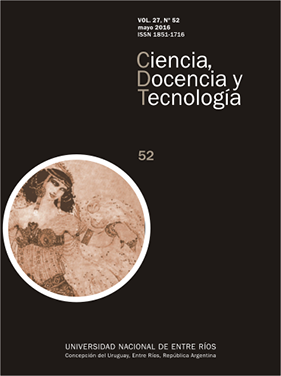Creativity and Science. A biographical study of Argentine scientists
Keywords:
Argentine scientists, creative systems, knowledge production, innovation, science and technologyAbstract
Creativity is a requirement of science. Scientific developments require permanent activation of creative processes associated with knowledge production. Contextual biographical study of creative processes developed by Argentine scientists who have made significant contributions in various areas of research is presented. Analyzes support the consideration of creativity as socio-cultural process that involves multiple interactions with other people and different cultural objects. The knowledge learned and built with other play a prominent role in science creative process. The study of the lives of creative scientists shows the complexity of creativity and offers interesting gaps for science teaching and research methodologies. It also provides insight into how creative ideas beyond the fields of knowledge and are critical to the development of science, technology and education.
Downloads
References
ACEVEDO DÍAZ, J. (2004). El papel de las analogías en la creatividad de los científicos, en: Revista Eureka sobre Enseñanza y Divulgación de las Ciencias, 1(3): 1-10. Disponible en: http://www.redalyc.org/pdf/920/92001304.pdf [20 de febrero de 2015].
AMABILE, T. y PILLEMER, J. (2012). Perspectives on the Social Psychology of Creativity, en: Journal of Creative Behavior, 46(1): 3–15.
ANDERSON, T. (2011). Beyond eureka moments: supporting the invisible work of creativity and innovation, en : Information Research, 16(1):1-10.
BAHADIR, A. y SAK, U. (2014). Objective measure of scientific creativity: Psychometric validity of the Creative Scientific Ability Test, en: Thinking Skills and Creativity, 13: 195–205.
BEGHETTO, R. y KAUFMAN, J. (2014). Classroom contexts for creativity, High Ability Studies. Disponible en: www.ronaldbeghetto.com/s/ClassroomContextsBeghettoKaufman2014.pdf [10 de febrero de 2015].
BERNAOLA, O. (2002). Enrique Gaviola y la física en la Argentina de entreguerras, en: Saber y Tiempo, 4(14): 93-118.
BIANCO, M. Y SUTZ, J. (2005). Las formas colectivas de la investigación universitaria, en Revista Iberoamericana de Ciencia, Tecnología y Sociedad, 2 (6): 25-44.
CAPPOZZO, L. (2012). Cristhiane Dosne de Pasqualini, Colección Conociendo a nuestros científicos, La Punta: Universidad de La Punta. Disponible en: http://www.ulp.edu.ar/comunicacion/ebook/pasqualininov12/index.html [25 de febrero de 2015].
CASTRO, E. y OLMOS, J. (2014). Características de las interacciones con la sociedad de los investigadores de humanidades y ciencias sociales a partir de estudios empíricos, en: Revista Iberoamericana de Ciencia, Tecnología y Sociedad, 9 (27): 113-141.
CAZAUX, D. (2012). Eugenia Sacerdote de Luistig, La Punta: Universidad de La Punta. Disponible en: http://www.ulp.edu.ar/comunicacion/ebook/lustignov12/files/libro.pdf [21 de febrero de 2015].
CRAFT, A., HALL, E. y COSTELLO, R. (2014). Passion: Engine of creative teaching in an English university?, en: Thinking Skills and Creativity,13: 91–105.
CZEMERINSKI, H. y JACOVKIS, P. (2011). La llegada de la computación a la Universidad de Buenos Aires, en: Revista Iberoamericana de Ciencia, Tecnología y Sociedad, 6 (18): 65-87.
CSIKSZENTMIHALYI, M. (2014). The Systems Model of Creativity and Its Applications, pp. (543-545). En D, Simonton (ed.) The Wiley Handbook of Genius, Chichester: John Wiley y Sons.
DAMIAN, R. y SIMONTON, D. (2014). Diversifying Experiences in the Development of Genius and their Impact on Creative Cognition, (pp.375-394). En D. Simonton (ed.) The Wiley Handbook of Genius, Chichester: John Wiley y Sons.
DARBELLAY, F., MOODY, Z., SEDOOKA, A. y STEFFEN, G. (2014). Interdisciplinary Research Boosted by Serendipity, en: Creativity Research Journal, 26 (1): 1-10.
DOSNE DE PASCUALINI, C. (2007). Quise lo que hice. Buenos aires: Leviatán.
DUCO, A. (2013). Luis Augusto Huergo. La Punta: Universidad de La Punta.
ELISONDO, R. (2013). Potencialidades creativas en contextos cotidianos en D. Donolo y R. Elisondo (Eds.) Estudio de Creatividad. Las travesías de Alfonsina, de Astor, de Julios y de Marías. La Laguna: Sociedad Latina de Comunicación Social, pp. 47-390. Disponible en: http://www.revistalatinacs.org/067/cuadernos/10CBA.pdf [20 de febrero de 2015].
ELISONDO, R. y DONOLO D. (2014a). Interculturalidad, apertura a experiencias y creatividad. Aportes para una educación alternativa, en: Revista Red, 41:15-25. Disponible en: http://www.redalyc.org/pdf/547/54731315004.pdf [20 de febrero de 2015].
ELISONDO, R. y DONOLO, D. (2014b). Creatividad e Innovación ¿Cómo lo hacen en Investigación y Ciencia? La Laguna: Sociedad Latina de Comunicación Social. Disponible en: http://issuu.com/revistalatinadecomunicacion/docs/cac65 [20 de febrero de 2015].
ELISONDO, R., DONOLO, D. y RINAUDO, M. (2013). Houssay, Leloir y Milstein: procesos creativos en las ciencias, en: Fundamento de Humanidades, 26: 99-114.
ERAZO, M. (2011). Rigor científico en las prácticas de investigación cualitativa, en: Ciencia, docencia y tecnología, 42: 107-146.
ETCHEZAHAR, E. (2014). La construcción social del género desde la perspectiva de la Teoría de la Identidad Social, en Ciencia, Docencia y Tecnología, 25(49): 128-142.
FABRIS, F. (2009). Pichon-Rivière, irrupción y génesis de un pensamiento, en: Revista Intersubjetivo de Psicoterapia Psicoanalítica y Salud, 1(10): 11-28.
FEIST, G. (2012). Predicting interest in and attitudes toward science from personality and need for cognition, en: Personality and Individual Differences, 52(7): 771-775.
FELD, A. (2011). Las primeras reflexiones sobre la ciencia y la tecnología en la Argentina: 1968-1973, en: Redes, 17 (32): 185-221.
GARCIA, M. y MATKOVIC, L. (2012). El poder de la imaginación y de la creatividad para hacer ciencia, en: Revista Química Viva, 1 (11): 54-68.
GARDNER, H. (1993). Mentes creativas. Barcelona: Paidos.
GHASSIB, H. (2010). Where does creativity fit into a productivist industrial model of knowledge production?, en: Gifted and Talented International, 25(1): 13-20.
GLAVEANU, V. (2010). Paradigms in the study of creativity: Introducing the perspective of cultural psychology, en: New Ideas in Psychology, 28 (1): 79-93.
GLAVEANU, V. y TANGGAARD, L. (2014). Creativity, identity, and representation: Towards a socio-cultural theory of creative identity, en: New Ideas in Psychology, 34: 12–21.
GLAVEANU, V. (2014). The Psychology of Creativity: A Critical Reading, en: Creativity: Theories-Research-Applications, 1: 10-32.
GRUBER, H. y WALLACE, D. (1999). The case study method and evolving systems approach for understanding unique creative people at work (pp. 93-115). En R. Sternberg (ed.) Handbook of Creativity, New York: Cambridge University Press.
HOLM-HADULLA, R. (2013). The Dialectic of Creativity: A Synthesis of Neurobiological, Psychological, Cultural and Practical Aspects of the Creative Process, en: Creativity Research Journal, 25 (3): 293-299.
JACOVKIS, P. (2004). Reflexiones sobre historia de la computación en la Argentina, en: Saber y Tiempo, 5(5): 129-148.
KAUFMAN, S. (2013). Opening up Openness to Experience: A Four‐Factor Model and Relations to Creative Achievement in the Arts and Sciences, en: The Journal of Creative Behavior, 47(4): 233-255.
KAUFMAN, J y BEGHETTO, R. (2009). Beyond Big and Little: The Four C Model of Creativity, en: Review of General Psychology, 13 (1): 1–12.
KREIMER, P. (2011). La evaluación de la actividad científica: desde la indagación sociológica a la burocratización. Dilemas actuales, en: Propuesta educativa, 20(36): 59-77.
KOZBELT, A., BEGHETO, R. y M, RUNCO (2010). Theories of Creativity, (pp. 20-47). En Kaufman y Sternberg, The Cambridge Handbook of Creativity. Cambridge: Crambridge Press.
LOPEZ, M. (2013). Capacidades y condiciones institucionales de internacionalización en los grupos de investigación, en: Ciencia, docencia y tecnología, 46: 69-93.
LONG, H. (2014). An Empirical Review of Research Methodologies and Methods in Creativity Studies (2003–2012), en: Creativity Research Journal, 26 (4): 427-438.
LEUNG, A. y CHIU, C. (2010). Multicultural experiences, idea receptiveness, and creativity, en: Journal of Cross-Cultural Psychology, 41: 723–741.
MCCRAE, R. y GREENBERG, D. (2014). Openness to Experience (pp.222-243). En D. Simonton (ed.) The Wiley Handbook of Genius. Chichester: John Wiley y Sons.
MADDUX, W., ADAM, H. y GALINSKY, A. (2010). When in Rome…learn why the Romans do what they do: How multicultural learning experiences enhance creativity, en: Personality and Social Psychology Bulletin, 36: 731–741.
MENDOZA, D y M. DE ASUA (2002). La historia de la ciencia en la Argentina de entreguerras, en Saber y Tiempo, 4 (14): 137-161.
METZL, A. y M. MORRELL (2008). The Role of Creativity in Models of Resilience: Theoretical Exploration and Practical Applications, en: Journal of Creativity in Mental Health, 33 (3): 303-318.
MILLER, A. (1996). Metaphors in Creative Scientific Thought, en: Creativity Research Journal, 9 (2-3): 113-130.
MILLER, A. (2007). Einstein y Picasso. El espacio, el tiempo y los estragos de la belleza. Barcelona: Tusquest Editores.
MUMFORD, M., HESTER, K. y ROBLEDO, I. (2010). Scientific creativity: Idealism versus pragmatism, en: Gifted and Talented International, 25(1): 59-64.
PALADINI, A. (2007). Leloir. Una mente brillante. Buenos Aires: Eudeba.
PALMA, H. (2005). El desarrollo de las ciencias a través de las metáforas: un programa de investigación en estudios sobre la ciencia, en: Revista Iberoamericana de Ciencia, Tecnología y Sociedad, 2 (6): 45-65.
POLICASTRO, E. y GARDNER, H. (1999). From case studies to robust generalizations, (pp. 213-225). En R. Sternberg (ed.) Handbook of Creativity. Cambridge: Cambridge University Press.
RICHARDS, R. (2007). Everyday creativity and new views of human nature. Washington: American Psychological Association.
RITTER, S., RODICA, D, SIMONTON, D., VAN BAAREN, R., STRICK, M., DERKS, J. y DIJKSTERHUIS, A. (2012). Diversifying experiences enhance cognitive flexibility, en: Journal of Experimental Social Psychology, 48: 961–964.
RUNCO, M. (2010). Creativity: Theories and themes: Research, development, and practice. Londres: Elseviser Academic Press.
SÁBATO, J. (2004). Ensayos en campera. Buenos Aires: Universidad Nacional de Quilmes.
SBARBATI NUDELMAN, N. (2015). Educación en ciencias basada en la indagación, en: Revista Iberoamericana de Ciencia, Tecnología y Sociedad, 10 (28): 11-21.
SÁNCHEZ-RUIZ, M., ROMO, M. y JIMÉNEZ J. (2013). The Role of Metaphorical Thinking in the Creativity of Scientific Discourse, en: Creativity Research Journal, 25 (4): 361-368.
SCHMIDT, A. (2011). Creativity in Science: Tensions between Perception and Practice, en Creative Education, 2 (5): 435-445.
SILVIA, P., BEATY, R., NUSBAUM, E., EDDINGTON, K., LEVIN-ASPENSON, H. y KWAPIL, T. (2014). Everyday creativity in daily life: An experience-sampling study of little c creativity, en Psychology of Aesthetics, Creativity, and the Arts, 8 (2): 183-188.
SIMONTON, K. (2004). Creativity in Science. Cambridge: Cambridge University Press.
SPIVAK, A. y M. HUBERT (2012). Movilidad científica y reflexibilidad. De cómo los desplazamientos de los investigadores modelan modos de producir conocimientos, en: Redes, 18 (34): 85-111.
SPORTONO, A. (1995). Prólogo Osvaldo A. Reig, en: Revista Chilena de Historia Natural, 68: 161-169.
STAKE, R. (1998). Investigación con estudio de casos, Madrid, Ediciones Morata.
STERNBERG, R. (2010). Limits on science: A comment on where does creativity fit into a productivist industrial model of knowledge production?, en: Gifted and Talented International, 25(1): 21-22.
SULLOWAY, F. (2104). Openness to Scientific Innovation, (pp.546-563). En D. Simonton (ed.) The Wiley Handbook of Genius, Chichester: John Wiley y Sons.
TANGGAARD, L. (2012). The sociomateriality of creativity in everyday life, en: Culture y Psychology, 19 (1): 20-32.
VALLADARES, L. (2010). La educación científica intercultural y el enfoque de las capacidades, en: Revista Iberoamericana de Ciencia, Tecnología y Sociedad, 16 (6): 39-69.
VASILACHIS, I. (2009). Los fundamentos ontológicos y epistemológicos de la investigación cualitativa, en: Forum: Qualitative Social Research, 10 (2): 10-20.
VONÈCHE, J. (2003). The Changing Structure of Piaget’s Thinking: Invariance and Transformations, en: Creativity Research Journal, 15 (1): 3–9.
WEISBERG, R. (2010). The study of creativity: from genius to cognitive science, en International Journal of Cultural Policy, 16 (3): 235–253.
WEISBERG, R. (2014). Case Studies of Genius: Ordinary Thinking, Extraordinary Outcomes, (pp.139-165). En D. Simonton (ed.) The Wiley Handbook of Genius, Chichester: John Wiley y Sons.
WEISSMAN, M. (2013). Entrevista en la Académica Nacional de Ciencias Exactas, Físicas y Naturales. Disponible en: http://www.ancefn.org.ar/comunidad/videoteca02.html [20 de febrero de 2015].
ZITO LEMA, V. (1976). Conversaciones con Enrique Pichon Riviere. Sobre el arte y la locura. Buenos Aires: Timerman Editores.
YIN, R. (2013). Case study research: Design and methods. Londres: Sage publications.
Downloads
Published
How to Cite
Issue
Section
License
The authors retain the copyright and grant the journal the right to be the first publication of the work, as well as licensing it under a Creative Commons Attribution License that allows others to share the work with an acknowledgment of the authorship of the work and publication initial in this magazine. All content is published under the Creative Commons 4.0 international license: Attribution-Non-Commercial-Share Alike.






